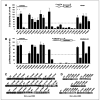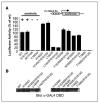Determination of cancer risk associated with germ line BRCA1 missense variants by functional analysis
- PMID: 17308087
- PMCID: PMC2936786
- DOI: 10.1158/0008-5472.CAN-06-3297
Determination of cancer risk associated with germ line BRCA1 missense variants by functional analysis
Abstract
Germ line inactivating mutations in BRCA1 confer susceptibility for breast and ovarian cancer. However, the relevance of the many missense changes in the gene for which the effect on protein function is unknown remains unclear. Determination of which variants are causally associated with cancer is important for assessment of individual risk. We used a functional assay that measures the transactivation activity of BRCA1 in combination with analysis of protein modeling based on the structure of BRCA1 BRCT domains. In addition, the information generated was interpreted in light of genetic data. We determined the predicted cancer association of 22 BRCA1 variants and verified that the common polymorphism S1613G has no effect on BRCA1 function, even when combined with other rare variants. We estimated the specificity and sensitivity of the assay, and by meta-analysis of 47 variants, we show that variants with <45% of wild-type activity can be classified as deleterious whereas variants with >50% can be classified as neutral. In conclusion, we did functional and structure-based analyses on a large series of BRCA1 missense variants and defined a tentative threshold activity for the classification missense variants. By interpreting the validated functional data in light of additional clinical and structural evidence, we conclude that it is possible to classify all missense variants in the BRCA1 COOH-terminal region. These results bring functional assays for BRCA1 closer to clinical applicability.
Conflict of interest statement
Figures




References
-
- Smith DJ, Lusis AJ. The allelic structure of common disease. Hum Mol Genet. 2002;11:2455–61. - PubMed
-
- Friedman LS, Ostermeyer EA, Szabo CI, et al. Confirmation of BRCA1 by analysis of germline mutations linked to breast and ovarian cancer in ten families. Nat Genet. 1994;8:399–404. - PubMed
-
- Chapman MS, Verma IM. Transcriptional activation by BRCA1. Nature. 1996;382:678–9. - PubMed
Publication types
MeSH terms
Substances
Grants and funding
LinkOut - more resources
Full Text Sources
Other Literature Sources
Miscellaneous

